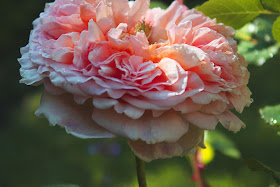 |
| Fig. 1 Colorful chards. |
Many times in the past I was deceived by our spring weather. It would start to get dry and warm by March and I've interpreted those as a signal to plant warm-season vegetables. Then we would get a sudden cold temperature damaging young plants. This year however, has been mild that I was able to grow cool-season crops before it got too warm. The temperature is staying consistently pleasant and gradually increasing. The weather has been very favorable for starting new plants - both annuals and perennials. As I write this post, the temperature outside is close to 80 degrees F - the warmest day of the season (in our area), so far.
Here is a list of the vegetables and herbs that are currently growing in my garden:
Lettuce
Swiss Chard
Arugula
Tomato
Cucumber
Raddish
Potato
Jalapeno Pepper
Japanese Eggplant
Zucchini
Strawberry
Rhubarb (new this year)
Onions
Chives
Garlic Chives,
Cilantro
Basil
Italian Parsley
 |
| Fig. 2 Swiss chard 'Rainbow' (Beta vulgaris) |
This is my first time planting 'Rainbow' Swiss chard in my garden and I am glad I did. They are very healthy and colorful (Fig. 1 and Fig. 2). They are very nutritious and yet they look so ornamental.
 |
| Fig. 3 Arugula (Eruca sativa) |
I have a pomegranate tree growing in a large pot (Fig. 3) and I thought of planting a fast growing annual crop with it. The tree was still leafless at the time of sowing; now its leaves provides a slight shade for the arugula. This arrangement works really well that it will surely be repeated next year. I did the same thing last fall when I planted
bok choy with a Ficus tree.
Fig. 4 Lettuce (Lactuca sativa 'Red Sails' and 'Black-Seeded Simpson')
I planted two varieties of lettuce namely, 'Red Sails' and 'Black-Seeded Simpson'. Both varieties have similar growth habits (Fig.4); the leaves are crumpled with edges that are frilly. 'Black-Seeded Simpson' has bright and almost-neon green leaves. 'Red Sails' is an award winning variety with glossy red-purplish leaves. It is fast maturing (45 days) and resistant to bolting or flowering which allows for a prolonged season of great tasting lettuce.
Basil are just emerging with their first set leaves, pole beans seeds were planted last week.
 |
| Fig. 5 Easter Sunday: Kids invaded the vegetable garden in search of eggs. |
It's that time again when plant parts that we consider food begin to find their way to the kitchen.


















